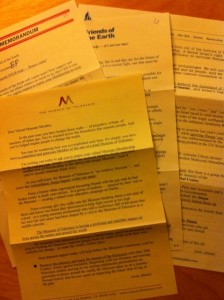Three Ways to Keep Copy Fresh
/ The other day, my 8-year-old asked me what I did at work. Patiently, I explained (again) that I write letters asking for money for organizations that help people. She rolled her eyes and said, "I know that! I meant what did you do today?" I told her that I worked on a letter for one of my clients. She heaved a big, 8-year-old sigh and said, "Yeah...but, well, do you just write the same letter over and over?"
Nearly every time I sit down at the computer and stare at the blank screen, it feels like a brand new mountain to climb. There are new facts to learn, new victories to share, new programs to ask for money for. Most of the time, I feel energized by the work that I do. Each letter is a new opportunity to delve deeper into an organization's mission and to find new ways of telling their story.
The other day, my 8-year-old asked me what I did at work. Patiently, I explained (again) that I write letters asking for money for organizations that help people. She rolled her eyes and said, "I know that! I meant what did you do today?" I told her that I worked on a letter for one of my clients. She heaved a big, 8-year-old sigh and said, "Yeah...but, well, do you just write the same letter over and over?"
Nearly every time I sit down at the computer and stare at the blank screen, it feels like a brand new mountain to climb. There are new facts to learn, new victories to share, new programs to ask for money for. Most of the time, I feel energized by the work that I do. Each letter is a new opportunity to delve deeper into an organization's mission and to find new ways of telling their story.
But everyone has days where work feels like, well, work.
And one of the most important parts of my work is making sure I don't write the same letter over and over. Believe me, donors can tell when you're phoning it in. They know when your copy is less-than-inspired, and they respond by NOT responding.
So how do I keep it fresh each and every time?
- Micro-editing. Like all writers, I have words and phrases I favor. Organizations have those too. I combat all that boilerplate with aggressive line-by-line editing. A stronger word or a more active phrase can liven up even the most lifeless copy.
- Read it aloud. A direct mail letter is a personal letter from one individual at your organization to one donor. It should sound like that person talking to a friend. When you read it aloud, you can hear those boring recitations of facts for what they are: turn-offs. Bonus -- you can also spot the complicated turns-of-phrase, the too-long sentences and the just-plain-awkward asks.
- Turn it on its head. Say something unexpected. Use a metaphor or simile that no one would anticipate. Ask a question that cuts to the heart of your issue (and leads the donor right to where you want them to go). Take advantage of literary techniques like assonance and alliteration. Make a pun. Unleash your creativity and see where it takes your letter. (You can always cut those bits that don't work out, but taking the risk is bound to pay off now and then!)
I told my daughter a few more details about the letter I was working on that day -- for an environmental organization -- and it led to a great dinner-table discussion about conservation and natural resources. The next day, I heard her telling one of her friends, "My mom writes a lot of letters, but they're not all the same, even though it kind of sounds like they could be."
I couldn't have said it better myself.
